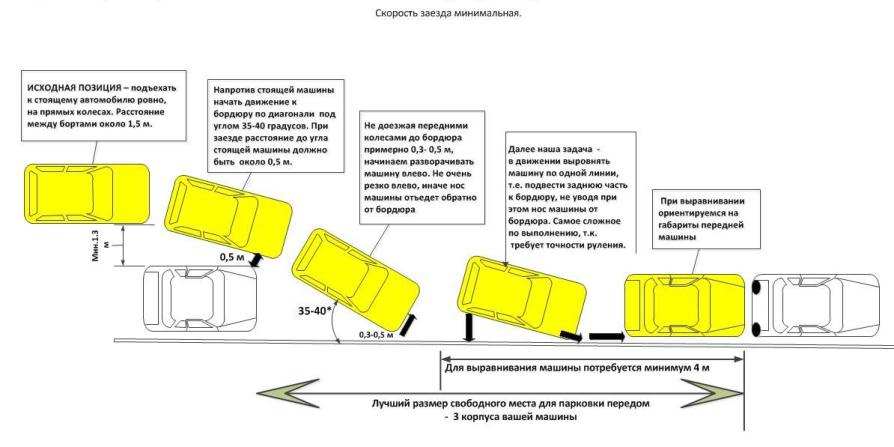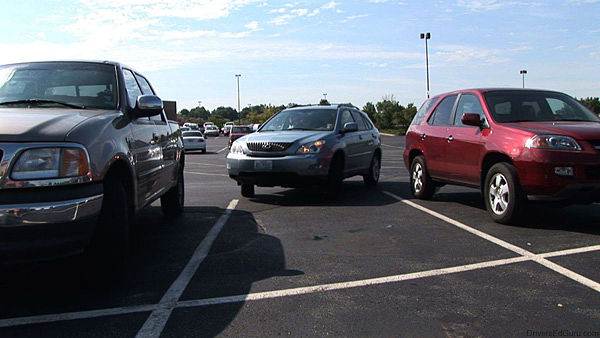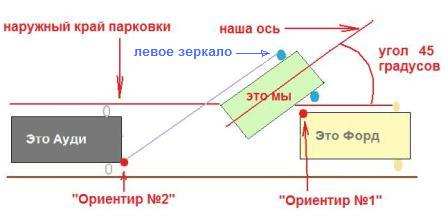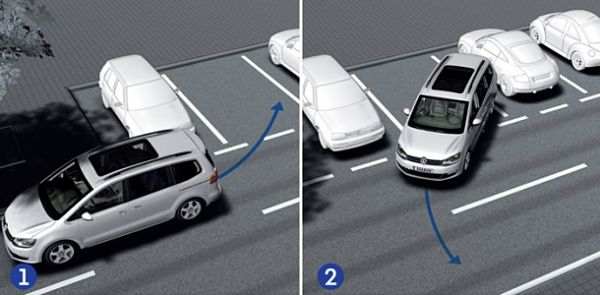How to park forward and backward
It is no secret that the existing driving schools practically do not provide any driving skills, and even more so for performing certain difficult maneuvers in a car. The negligible number of hours devoted to practicing driving skills is enough only for getting to know the controls and short trips along city routes. Therefore, most car enthusiasts have to learn on their own how to park correctly, how to enter the garage and the inspection pit, etc.
So you need to know how to park, though how to drive back))
The modern metropolis with its crazy heavy traffic and traffic density puts a lot of psychological pressure on newcomers. There is literally nowhere to stick your car in during rush hours. The roadsides and parking lots are occupied by a line of densely parked cars, it is not so easy to drive into an empty space and not to block the exit for others. This requires certain hours of training in a vacant lot or in the yard in order to "fill" an eye and a hand and adapt to the peculiarities of the behavior of your car.
How to park correctly in front
The easiest way to park is to park your car forward. Usually, such a scheme is used in parking lots near shopping centers, in underground garages of hypermarkets, in paid parking lots, in the courtyards of residential areas in designated areas specially designated for cars. With the right skills, this method takes the least time and is easy to learn.
Front parking methods

You can park in front of the parking lot parallel or perpendicular to the curb of the road or parking area. It is convenient to park a car along the curb of the road, because it will be easier to leave the parking lot. However, you can do this only when there are few cars and a lot of free space (the distance between neighboring cars is 2 times the length of your car). In most cases, permitted parking spaces are marked perpendicular to the curbs or at a certain angle in the direction of travel. Therefore, it is extremely rare to park in a parallel way in a large metropolis.

With perpendicular parking in front, there is nothing difficult, the main thing is to be careful
Parking rules perpendicular to the curb simple enough. In order not to hit a neighboring car when entering a parking lot, remember that the turning radius of the rear wheels is shorter than that of the front wheels. They shorten (cut) the turn. Therefore, you need to turn the steering wheel in the direction of the parking lot at the moment when the bumper of a standing adjacent car has already passed the middle pillar of the doors of your car.
To quickly learn how to park in a forward direction, first ask a friend or the valet parking attendant to help you adjust your actions outside. Two or three practice runs will be enough to build confidence in your actions. A good helper in this matter are those with all-round visibility.
How to correctly drive up to the parking lot
Arriving at your destination, you need to worry about the upcoming parking in advance. To do this, you need not to slip through the free parking space, occupying the extreme right lane and snuggling closer to the curb. If someone is leaving the parking lot in front of you, freeing up free space, then you can stop and turn on the right turn signal lamp. Thus, you declare to others about your intention to take this place.
According to the parking rules, it is necessary to give space to the driving off car to perform the necessary maneuver. After that, proceed to implement your own maneuver. The dimensions of the free space must accommodate at least 1.5 times the length of your car in order to safely park without problems for others.
How to reverse parking correctly
Reversing the car especially requires a lot of training to reinforce the skills to reverse the mirror reaction of the car to the steering wheel rotation. In this case, the driver must have good spatial awareness and imagination. This option of parking the car is more difficult and time-consuming than parking at the front. However, reverse parking allows you to quickly and without unnecessary maneuvers to leave the parking lot when leaving.
The most difficult way to park cars is considered to be parking cars in one line, when they are installed one after another parallel to the road or parking curb. This method is often found on narrow streets next to shops, offices, on the driveways to residential multi-storey buildings. For the successful implementation of this method, it is necessary to have a space between cars 1-1.2 m more than the length of your car.

Reverse parallel parking diagram. But for a better understanding, watch the video.
Sequence of Reverse Parallel Parking Operations includes the following steps:
- To start the maneuver, you need to pass the parking place and stop next to the front standing car. The interval between it and your car should be within 0.5-1 meters. The wheels must be level.
- Starting a slow movement backward, you need to control this interval, not allowing convergence. Noticing the rear bumper of this car on the right side rear-view mirror, you need to stop.
- After unscrewing the wheel to the right to the end, continue in reverse, observing the image of the rear car in the left rear-view mirror. When the right headlight of the rear car and its entire front are observed in the mirror, you must press the brake.
- Align the steering wheel and continue driving backwards, controlling by the right mirror interval to the first car. The rear light first appears in the mirror, then it gradually leaves the field of view.
- Turn the steering wheel to the left to the end and continue slowly moving backward, while simultaneously controlling in the rear-view mirrors the distance to the rear car and through the windshield to the front car, which can be hooked on with the bumper when performing such a maneuver. If you do not fit into such a turn, then errors were initially made in the distance calculations, and all maneuvers must be started anew.
- When the car reaches a position parallel to the curb, you need to stop, align the wheels and drive forward, setting the same distance between the front and rear vehicles.
This completes parallel parking in reverse. At the same time, neither the nose nor the rear of the car should protrude from the general row of cars and interfere with passing vehicles. To comply with safety rules, you need to consider how to install the front wheels in a parking lot with a slope. If you are parked on a downhill, then the wheels should be turned towards the curb. On the rise, on the contrary, the wheels should be turned away from the curb. In this case, the curb is a natural stop that prevents the car from moving independently on a slope when the parking brake fails.

Sequence of actions for perpendicular rear parking

The final maneuver. For more details watch the video
To park the car perpendicular to the curb, you need to find a free space between the standing cars that exceeds the width of your car, taking into account the open doors. This method is much simpler than the previous one and takes less time. For the correct execution of perpendicular parking in reverse, it is recommended to observe the following procedure:
Detailed video about perpendicular rear parking
- Approaching a nearby parked car, turn sharply to the left at the moment of aligning your right mirror with the right headlight of this car. Drive forward with the car perpendicular to the curb.
- Align the wheels and slowly back up, controlling the distance to the first and second car on both side mirrors. Turn the steering wheel to achieve approximately the same distance to the cars on the right and left sides.
Video: Reverse Parking Part 2
Stop the car as close to the curb as possible so that its nose does not protrude beyond the common line of parked cars.
Several independent attempts under the supervision of a valet or a friend will quickly gain confidence, develop an eye and skills in management.
The benefits of practical training
Experience is an irreplaceable assistant to any driver. And it is acquired only in the process of practical driving. It is better to gain such experience in safe training conditions, when strangers and cars do not interfere, at special training grounds or wastelands. Light fences imitating the location of cars and buildings will not harm the body in case of errors in the calculation and accidental collision with them. Training will allow you to feel the size of the car, the turning radius of the front and rear wheels, the amount of distance distortion in the mirrors. In the end, they will bring a sense of driving satisfaction, relieve excessive nervousness.














